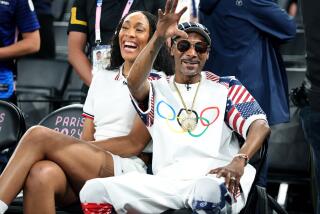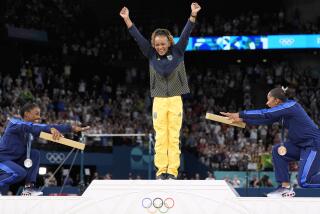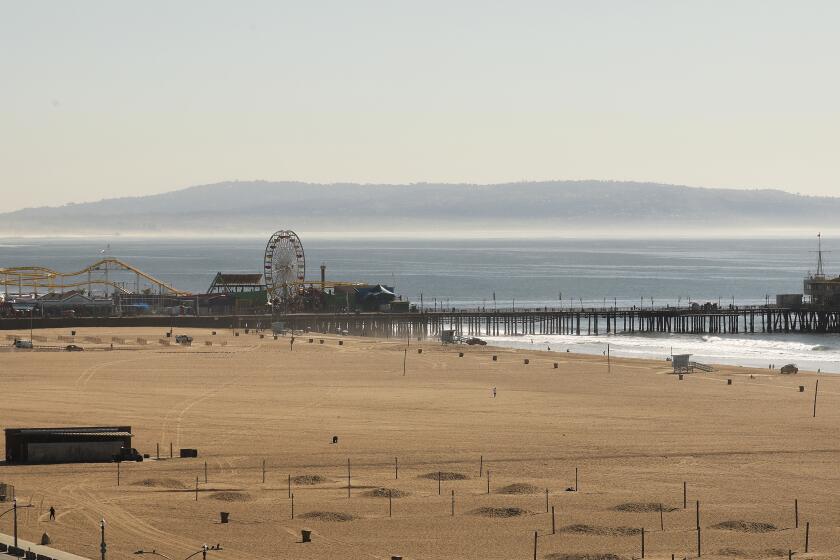The digital revolution takes the center ring
Look AT Bob Beamon’s record 29-foot, 2 1/2-inch long jump from the 1968 Summer Olympics on YouTube; it almost looks like a grainy animation. It was perhaps the greatest single Olympic performance ever -- after all, no one had long-jumped even 28 feet before and there has only been one jump longer than it in the four decades since. Beamon was the favorite, so there were two cameras on him, unusual in its day. Still, even with slow motion added, Beamon’s extraordinary leap lacks real visual oomph.
If Beamon were to jump in the upcoming Beijing Olympics, it wouldn’t just be that cliched “up close and personal” but, according to the honchos at NBC Sports, more like “UPCLOSEZAMWOWEE!!” It’s all about HD, which will come of age in these Games.
“There really will have been nothing like it,” said David Neal, executive producer of NBC Sports and Olympics, which is finishing a five-Olympics, $3.5-billion rights package in China. “The base headline for me is that this will be the first 100% high-definition TV big event -- of any kind. After seeing the Beijing Olympics, it will be hard to look at many things, but particularly sporting events, in anything other than HD.”
NBC’s coverage, which starts at 2 a.m. Wednesday PDT with a preliminary women’s soccer match between Brazil and Germany, could well signal a shift in the way people watch sporting events, and maybe big events of all sorts, in the future. In addition to hyperrealistic HD, it will no longer be just your couch-potato Olympics.
“We have to respond in covering the Olympics to what consumers are demanding in general,” said Gary Zenkel, president of NBC Olympics, speaking, like Neal, by phone from Beijing. “We are trying to provide expanding and wonderful coverage, but it is also about allowing the user to control the schedule.”
Thus, NBC will be supplying 2,200 hours of live streaming video from Beijing. There will be as many as 3,600 hours of content that can be downloaded to computers and mobile devices on demand afterward, and 1,400 hours of broadcasts. The network is mobilizing 106 commentators -- Bob Costas and Jim Lampley will be the main anchors -- and more than 2,900 employees.
Some of the more popular events -- swimming, gymnastics and beach volleyball, for instance -- will be held in the morning Beijing time, which is 15 hours ahead of Los Angeles, so they will be seen live on the West Coast in the late afternoon or evening.
--
High-tech springboard
Neal H. PILSON, the former president of CBS Sports who is now a broadcast consultant, said the implications of NBC’s Olympics coverage will be large. “The Olympics have become a platform for new technology,” said Pilson, who will be consulting for the International Olympic Committee on the broadcasts for the upcoming Vancouver, Canada, and London games. “NBC has been successful in broadening the distribution, using all its cable channels. But now you will be able to watch Olympics highlights in your office, in your bathroom, on the corner of Broadway and 42nd Street in New York. It has created more places too for sponsors to let you see their products, which is how you get the Olympics for free,” he said, acknowledging that the Olympics indeed are also an enormous commercial soundstage.
The Games in the past have been known as an important spot for various TV innovations.
Robert Thompson, founding director of the Bleier Center for Television and Popular Culture at Syracuse University, said the coverage of the 1968 Olympics caused a seismic shift. “Before 1968, no one remembers much about the Olympics on TV,” said Thompson, noting that sometimes film was coming in as much as a day late in 1960 and 1964. “But in 1968, both in Grenoble and Mexico City, ABC decided to make it a show.” He said that ABC sent 330 employees to Mexico City, almost as many as the U.S. Olympic team. This was the first time a network had databases with facts about every athlete and every event. “There was not a lot of technological wizardry, but with all the cameras and all the data, ABC made the Olympics a TV event, a vision that continues to today.”
Neal said that NBC will have some technological wizardry in Beijing, but it will mostly be centered around the push to high-definition TV, which digitally compresses the picture to make it look sharper and is now available in an estimated 14% of American homes.
“Four years ago, HD was a boutique operation,” said Neal. He said NBC used it only at five venues and the opening and closing ceremonies. All the high-definition cameras in Athens in 2004 were what are known as “hard cameras,” the large, stationary kind, not the more mobile hand-held ones. In Beijing, more than a thousand cameras for the international television feed, supervised by the Chinese, and all 80 NBC cameras for the network’s exclusive coverage, whether hand-held, miniature or hard, will be high-definition.
“It is really a case of the Chinese government wanting everything to be first-class and state of the art, and I think that is wise,” said Neal, who added that he is confident of a good production with no interference from the Chinese.
--
An array of visuals
NBC PLANS other tech gewgaws. For instance, NBC started using what Neal called “virtual graphics” during the Sydney Olympics in 2000, primarily for identifying swimmers. In each lane, for instance, the athlete’s name and the flag of his or her country would appear superimposed. For Beijing, that same kind of graphic will be in every kind of race, and in other contests, such as fencing. There will also be some satellite mapping and 3-D models of lengthier events such as mountain biking and the marathon.
Further, “lipstick cameras,” so named because of their size and shape, will be embedded in dozens of places, from the top of the pole vault bar, to the targets in archery, to the mats in wrestling.
NBC thinks that a lot of viewing may well be done in the workplace, at home at a computer, or on hand-held devices. It has partnered with Microsoft, requiring nbcolympics.com viewers to use that company’s “Silverlight” software to get streaming video and text data.
Zenkel said that users will be able to see as many as four screens of live feeds at once, or have a picture-in-picture feed on their computers. Those with AT&T; subscriptions will have what Zenkel called “a TV channel on your cellphone.” It will be a streaming feed of current programming designed for those subscribers. Other mobile customers will be able to sign up for text updates and alerts. All Web-based feeds will be advertiser-supported and so free to viewers.
“Video will be omnipresent. If an athlete was “in the marathon and so far behind we weren’t covering them, it may not be there,” he said. “But if they were in a badminton match or a race around the track or anything we would have covered like that, you can see the kid from your hometown any time you want.”
It is a case of the technology being available and the Olympics purveyor using it as a showcase. “In the 1980s, the Olympics coverage started using Chyrons, the superimposed title graphics, and you might have said ‘So what?’ at the time, but now it is what is expected in all sports, financial and news coverage,” said Steven A. Miller, coordinator of undergraduate studies at Rutgers University’s department of journalism and media studies. “I can see how this time, all the HD and the video on the Internet might force everyone from now on to do that on all programming.”
Neal certainly believes so, at least in the HD realm. “My friend, David Hill, who runs Fox Sports, gave a speech not long ago where he said that the transition to HD will be the biggest thing in television since the advent of color TV,” Neal said. “You will be able to see that happen right here with these Olympics. There will be a lot of high-definition televisions as Christmas gifts, I believe.”
More to Read
Go beyond the scoreboard
Get the latest on L.A.'s teams in the daily Sports Report newsletter.
You may occasionally receive promotional content from the Los Angeles Times.







